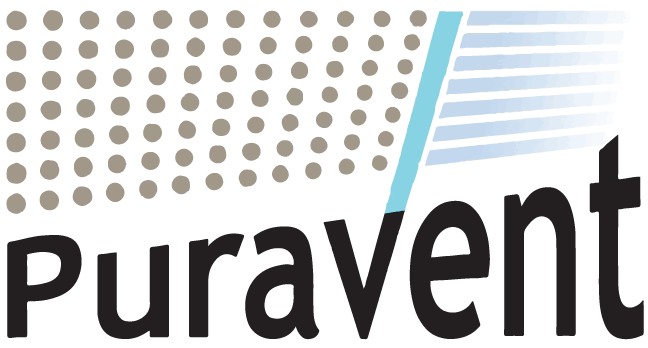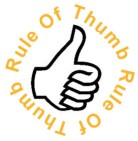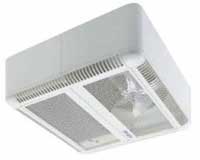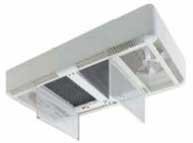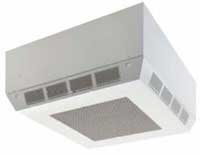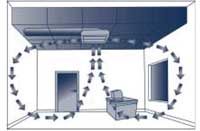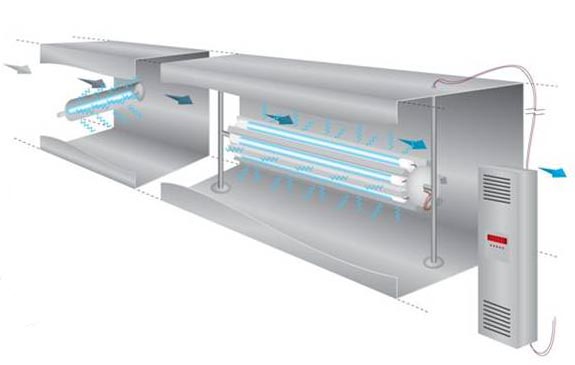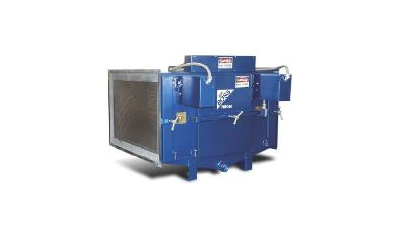A Guide to Commercial Air Cleaners

Commercial Air Cleaners – Background
When smoking in pubs, clubs and restaurants was commonplace, the market for various ceiling mounted commercial air cleaners was quite buoyant. There was much talk of segregated areas being introduced into these public places and the air-borne smoke being filtered from the air. During this time many very good commercial air cleaners were developed and sold, however, with the smoking bans being introduced in many European countries including the UK and Ireland the market all but dried up in a very short time. There are still occasional demands for the commercial air cleaners, but very rarely for the capture of cigarette smoke. In this guide we explain a bit about the different types of ceiling mounted air cleaners and how to select the most suitable for your application.
Commercial Air Cleaners – Applications
Commercial air cleaners find their use in rooms that need to be kept clean, whether they be offices, meeting rooms, laboratories, server rooms, shops, clubs, and pubs. Usually a room will have a particular issue not from dust generated inside the room but from fine dust that comes in from outside, where sources can vary from on-site industrial processes or materials handling, road dust, agriculture or construction dust, to city centre and main road traffic generated particulates such as diesel soot. Each application is unique and calls for some experience and skill to identify the best solution. Usually applications are to be found in smaller buildings without ducted ventilation systems, and therefore which do not benefit from a centralised air handling plant and its associated filters.
In factories and sites where there are offices and other relatively ‘clean’ rooms that suffer from dust issues, the issue with the room is quite different from the cause of the issue outside the room. In other words, although the two problems are related, they require quite different solutions. The dust source may be at least partly treatable using a local extract ventilation (LEV) equipment and dust collectors, however secondary dust issues, for instance where fine dust drift in, for instance, through doors and windows into offices and other clean areas, would require air cleaners. Dust ingress into a ‘clean’ area can raise health concerns, depending on the type of dust it is and its concentration. Not all dust issues have health implications – often dust in a ‘clean’ area will be a nuisance with dust getting into office machines and settling on surfaces, long before it is at a level where it is at a concentration where there are health concerns.
Although there is now a ban on smoking in public indoor environments, there are still applications for these air cleaners for treating tobacco smoke. Offshore and overseas applications crop up from time to time. Where units are required on ships or offshore platforms, we can provide units that run on 60Hz, which when via a step down transformer are suitable for installation in these situations.
Commercial Air Cleaners – Approach
At Puravent we have been supplying commercial air cleaners since we started trading in 2003 and are well placed to provide suitable air cleaners for your application. The type and number of air cleaner will not only depend on the size of the room in which the air cleaner(s) are to be used, but also what the type of dust is and what the level of contamination is. This is the guideline;
|
|
So lets assume that your room is a large office built within a dusty factory and it is 14m x 7m with a 3m ceiling. This gives an overall volume of 294m3. Lets aim to install enough air cleaning capacity to provide 10 air changes per hour. The total flow from the air cleaners needs to be 2940 m3/hr. We need to select air cleaners that can provide that air flow comfortably on say a medium speed so that there is capacity, if needed for an increased air change rate if needed, if the challenge warrants it. To select air cleaners based on their full speed means that you have to live with them constantly operating at their noisiest speed. Moreover sizing based on medium speed will mean much greater filter efficiency and life. As well as overall airflow rate also consider;
- Shape of the room – it might be a simple rectangle which would suggest that each of multiple units would be the same, or if it is a less regular shape say with a number of different size rectangular shapes then this usually suggests using different size units
- Ceiling type – if it has a suspended ceiling then there are models that can be mounted partly within the ceiling void, thus making less visual impact in the room space. If solid ceiling then there will be little choice, the unit will need to be one suited for surface mounting. Check dimensions of the unit and ensure that it is not going to be too low i.e. a ‘head banger‘
- Machine type – either based on mechanical filters or based on electrostatic collector plates. Electrostatic air cleaners have the huge benefit of not requiring replacement filters, and having ‘washable filters’, however they can make the occasional arcing (cracking) noise. Filter based machines require replacement filters from time to time and are therefore slightly more costly to run.
- Size – although both electrostatic and filter based machines are available in quite large sizes these are only really suitable in much larger rooms where the increased flow and noise, compared to smaller units, are not an issue.
Locating the air cleaners in the room will depend on the room size and shape but generally where there are multiple units they should be equidistant with half spacing to from the machine to the walls. A single unit should be as close to the centre of the room as reasonably possible
Commercial Air Cleaners – Machine Types
We supply electrostatic air cleaners. These are generally ceiling mounted and take air in via the lower face filter it and discharge it from the sides.
| Trion Series 60 | Trion Series 120 |
| Ceiling mount or ceiling recessed, electro static based air cleaner with air flow settings up to 680m3/hr | Ceiling mount or ceiling recessed, electro static based air cleaner with air flow settings up to 1360m3/hr |
| Trion Spacesaver | |
| Ceiling mount or ceiling recessed, electro static based air cleaner with air flow settings up to 1000m3/hr | The airflow pattern to virtually all ceiling mounted air cleaners |
|
Although these are our regular range of air cleaners we can supply other types and brands if required. Just ask us.
Commercial Air Cleaners – Operating Principles
Filter based commercial air cleaners are supplied as standard with high efficiency pleated filters, which are complimented by a washable open cell prefilter. The lower facing of the air cleaners can be hinged downwards for easy removal of filters and thus providing access to the fan unit above the filters. There is a choice of using a remote control or to have the control hard-wired back to a wall plate controller (off/low/medium/high speeds). The remote control units do cost a bit extra, however most customers opt to use the standard wall plate. This is a sensible precaution rather than relying on a remote controller which can break, get flat batteries or be lost. Where the air cleaning application is not straight forward the pleated filter can be substituted for a carbon filter.
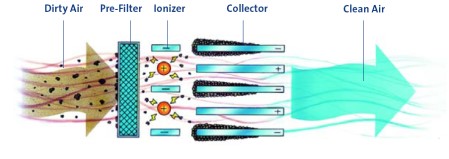
Electrostatic commercial air cleaner operating principle
Electrostatic commercial air cleaners also have a prefilter, but instead having a pleated disposable filter, they have an electrostatic collector cell. The dirty air passes into the air cleaner, where coarse dust and hair are trapped in the prefilter, whilst the fine dust particles are charged by the ioniser section. As the air carrying the charged particles then passes through the charged collector plates, the dust particles area repelled by the same charge plates, and at the same time attracted to the oppositely charged plates. The result is that the particles are diverted from the direction of air flow and are collected on the oppositely charged plates where they form a layer, that can be removed by periodic cleaning.
As with all air filters and air cleaning devices, the electrostatic air cleaners perform better, the slower the air is travelling though the collector cell. The flow through the electrostatic air cleaner is limited so that an acceptable performance is maintained for all fan speeds. In contrast to other types of filter electrostatic air cleaners perform better on smaller particles. The reason for this is that they have less mass and as a result are more easily from the air flow direction onto the collector plates, whilst heavier particles have more momentum and require more energy or distance of travel to change course and hit a collector plate.
In the Trion electrostatic air cleaners the collector plates are easily removed. They are arranged as a cell complete with the ionisers and come out as a single piece. The ease with which the dust can be washed off the collector cells depends on the type of contamination on the cells. Generally normal domestic type dust will sluff off with soaking in mild detergent, however where the cells also have other contaminants like cigarette smoke or oil mist, in addition to the regular dusts, the resultant crud may need a specialist detergent to remove. We supply a detergent for this called Tridex, which is available in a number of types and container sizes.
If you need help solving an indoor dust problem, ask us – 0845 688 0112
Guidelines and Regulations Concerning site dust (click title to activate link)
